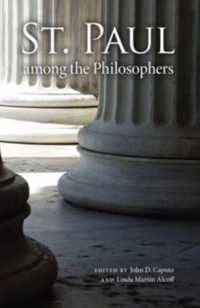- ホーム
- > 洋書
- > 英文書
- > Literary Criticism
基本説明
Investigates the strategies employed by German literature from 1750 to 1850 for increasingly attuning itself to quotidian life - common heroes, everyday life, non-extraordinary events - while also avoiding all notions of mediocrity.
Full Description
Following Hegel's analysis of art's increasing difficulty to both engage and extricate itself from prosaic reality, Paul Fleming investigates the strategies employed by German literature from 1750 to 1850 for increasingly attuning itself to quotidian life—common heroes, everyday life, non-extraordinary events—while also avoiding all notions of mediocrity. He focuses on three sites of this tension: the average audience (Lessing), the average artist (Goethe and Schiller), and the everyday, or average life (Grillparzer and Stifter).
The book's title, Exemplarity and Mediocrity, describes both a disjunctive and a conjunctive relation. Read disjunctively, modern art must display the "exemplary originality" (Kant) that only genius can provide and is thus fundamentally opposed to mediocrity as that which does not stand out or lacks distinctiveness; in the conjunctive sense, modern art turns to non-exceptional life in order to transform it—without forsaking its commonness—thereby producing exemplary forms of mediocrity that both represent the non-exceptional and, insofar as they stand outside the group they represent, are something other than mediocre.
Contents
Contents Acknowledgments vii Introduction 1 The Prose of the World, 1 The Werther Complex, 000 Literature, Exemplarity, and Mediocrity, 000 From Bourgeois Tragedy to Realism, 000 Chapter One: Exemplarity and Mediocrity 000 Exorbitant or Not at All, 000 Living the "Mean" Life (Aristotle), 000 Ruling Mediocrity (Horace), 000 Exemplary Originality (Kant), 000 Exemplary Averageness (Kant / Schiller), 000 Higher Criticism: Appreciating Mediocrity (Kleist), 000 Chapter Two. Common Heroes: The Making of an Exemplary Audience 000 (Lessing on Bourgeois Tragedy) How to Avoid A Tragic Fate, 000 Exceptional vs. Completely Common Characters, 000 Compassion: The Common, Exemplary Passion, 000 Art without Admiration, or, the End of the Age of Great Men, 000 How Many Tears should the "Best Human" shed?, 000 "Even mediocre artists can be successful," 000 "The applause is already very suspicious to me," 000 Chapter Three. Mediocre Artists: The Aesthetic Education of the Dilettante (Goethe and Schiller) 000 The Stamp of the Dilettante, 000 The Rise of Dilettantism, 000 Art's Invitation, 000 Goethe, the Dilettante, 000 The Problem of Popularity, 000 School of the Dilettantes, 000 Wilhelm Dilettante, or, The Art of Renunciation, 000 The Eternal Return of the Dilettante, 000 Chapter Four. Average Life: The Art of Prosaic Reality (Grillparzer and Stifter) 000 The Museum of Spirit, 000 Grillparzer's Lives of the Non-Famous, 000 The Dissonant Whole, 000 The Sublimity of Regularity (Stifter), 000 Perceptions of the Unperceivable, 000 The Statistical Law, 000 How Gentle is the Law?, 000 The Art of Prosaic Reality, 000 Conclusion 000 Bibliography 000 Index 000
-

- 電子書籍
- 冥王の柘榴(話売り) #2
-

- 電子書籍
- みらいのダンナさま(1) フラワーコミ…






